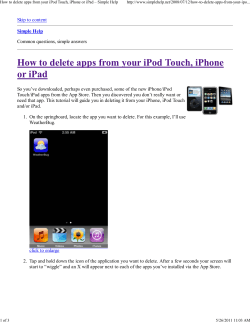
How to write what you want to say … copying
ot fo r co py in g How to write what you want to say … Sa m pl e N a guide for those students who know what they want to say but can’t find the words Patricia Hipwell in g co py Copyright © 2012 Patricia Hipwell This book is copyright. Apart from any fair dealing for the purpose of private study, research, criticism or review, as permitted under the Copyright Act, no part may be reproduced by any process without written permission. Enquiries should be addressed to the Publishers. ot fo r All rights reserved. First published 2012 Sa m pl e N National Library of Australia Cataloguing-in-Publication entry Author: Hipwell, Patricia. Title: How to write what you want to say : a guide for those students who know what they want to say but can’t find the words / Patricia Hipwell ; edited by Catherine Comiskey. ISBN: 9780987215901 (pbk.) Subjects: English language--Rhetoric. English language--Semantics. Creative writing. Other Authors/Contributors: Comiskey, Catherine. Dewey Number: 808.042 Typeset in Delicious 10 pt. Text and cover design: Watson Ferguson & Company Editing and proofreading: Catherine Comiskey, Kim Jones Assistance with the meanings of KEY TASK WORDS in Maths: Lyn Carter Note: Text examples of the writing skill have been created to demonstrate that skill. Possible inaccuracies and out-of-date information in these texts are acknowledged by the author and do not detract from the validity of their inclusion. Printed and bound by Watson Ferguson & Company, Salisbury, Brisbane, Australia. contents Sa m pl e N iv v 1 2 4 6 8 10 12 14 16 18 20 22 24 26 28 30 32 34 36 38 40 41 42 43 44 48 50 in g co py ot fo r dedication introduction key terms and ideas defined analysing arguing/persuading classifying comparing concluding contrasting describing elaborating evaluating explaining generalising inferring/interpreting justifying making recommendations providing evidence sequencing solving problems summarising synthesising avoiding the use of ‘I’, ‘me’ and ‘my’ avoiding the use of ‘said’ substitutes for ‘says that’ degrees of intensity (modality) key task word glossary my useful words and phrases about the author dedication Sa m pl e N ot fo r co py in g To my daughter, Elizabeth — the inspiration for this book, by being the embodiment of the student who knows what she wants to say but can’t always find the words! iv introduction co py in g This guide, written by Patricia Hipwell of logonliteracy, provides students with the language they need to write for a range of purposes. The book aims to provide students with a starting point to say what they want to say using language that mature writers use. The book is set out in a double-page format: ot fo r t The first page defines the WRITING SKILL and provides the SENTENCE STARTERS to demonstrate that skill. t The second page provides words or phrases for CONNECTING THE IDEAS WITHIN AND BETWEEN SENTENCES; an EXAMPLE of the SKILL in a short piece of writing; and the KEY TASK WORDS linked to the SKILL. N How to write what you want to say: Sa m pl e a guide for those students who know what they want to say but can’t find the words provides parents, teachers and students with a unique tool for improving writing. It suits students from the middle years of schooling to tertiary level. v pl e m Sa ot fo r N in g co py key terms and ideas defined the purpose of writing; includes such purposes as describing, comparing, evaluating, justifying sentence starter the opening clause of a sentence key task words words in questions that establish what is required in the answer formal language language that is more characteristic of how we write than how we speak; does not contain colloquialisms or slang; adheres to the conventions of print—grammar, spelling and punctuation are correct co py ot fo r expressing ideas such as possibility, certainty, frequency and importance using additional words to extend the main verb. Sa m pl e modality moda words or phrases that link or connect ideas within sentences or ideas from one sentence to the next N key connectives in g writing skill 1 meaning: co py the process of examining the parts of something in detail and discussing or interpreting the relationship of the parts to each other and to the whole; may involve description, comparison, explanation, interpretation and critical comment in g analysing mathematics meaning: ot fo r using statistical techniques to summarise, compare or infer something sentence starters ………. could be broken down in the following way/s: N The issue of ………. can be viewed from several different perspectives. The main similarities/differences between ………. and ………. are ………. pl e If ………. were changed, then the problem/issue/event/experiment would be affected in the following ways: ………. would happen if ………. was/were changed. ………. effectively combines ………. and ………. The actions of ………. enable us to understand ………. m Missing from the text is the ………. (view/perspective/opinion, etc.) of ………. There is a complex relationship between ………. and ………. Sa ………. is a fact because ………., whereas ………. is an opinion because ………. There is a strong connection between ………. and ………. ………. is composed of/combines with ………. In the case of ………., the following details have emerged: There is very little relationship between ………. and ………. All of the features of ………. contribute to ………. In the first/second/third instance, ………. ………. means that ………. 2 connecting ideas within and between sentences by for instance in the same way than comprises furthermore is made up of thus and this/that consists of however is similar to/ different from unless as well as differ/different if … then on the other hand when … then … because even if in addition provides for as long as for example in other respects some in g although and which is/allows/ gives co py yet example key task words see glossary pp. 44-47 t describe t analyse t compare t synthesise t interpret t break down t distinguish pl e N ot fo r The iPod Nano effectively merges two approaches to music storage and this makes it significantly different from its competitors. The iPod Nano’s tiny hard drive, which offers huge capacity, is combined with a memory chip which allows for a more compact design. The iPod Nano’s memory chips are incredibly small yet their four gigabyte capacity matches that of some hard drive players — the equivalent of 1000 songs. The absence of moving parts means that the iPod Nano is less delicate than full sized iPods and unlikely to skip. Sa m The high resolution colour screen provides sharp images which give stunning clarity to album-cover art, photo collections and the menu system. Navigation is made simple by the click-wheel scrolling device and this permits quick access to any one of the 1000 stored songs. The iPod Nano is light-weight and, even if it is dropped, the ear bud cord catches it. All of the features of the iPod Nano contribute to the appeal of this personal music player and ensure that it will be popular amongst lovers of personal music players everywhere. 3
© Copyright 2025





















